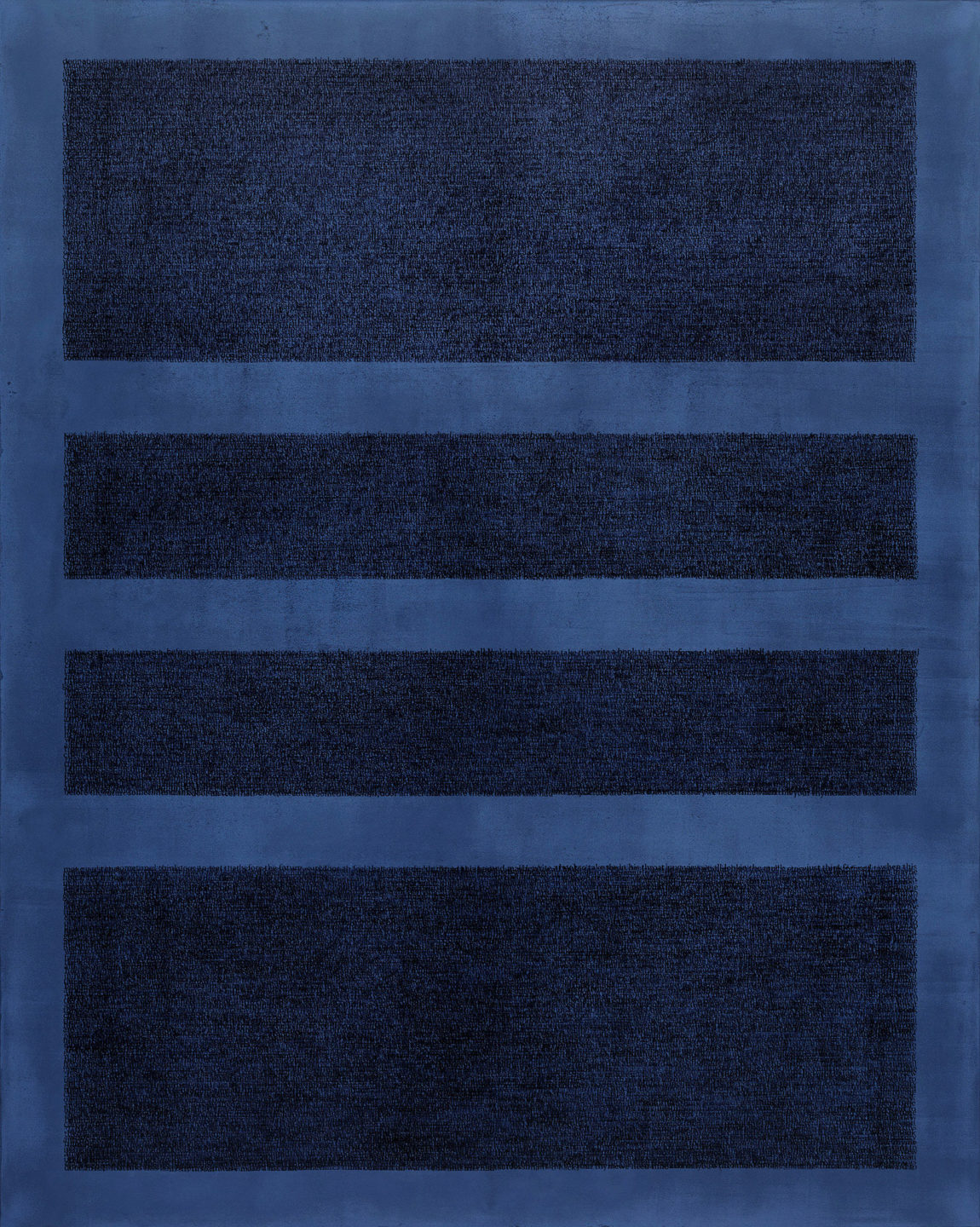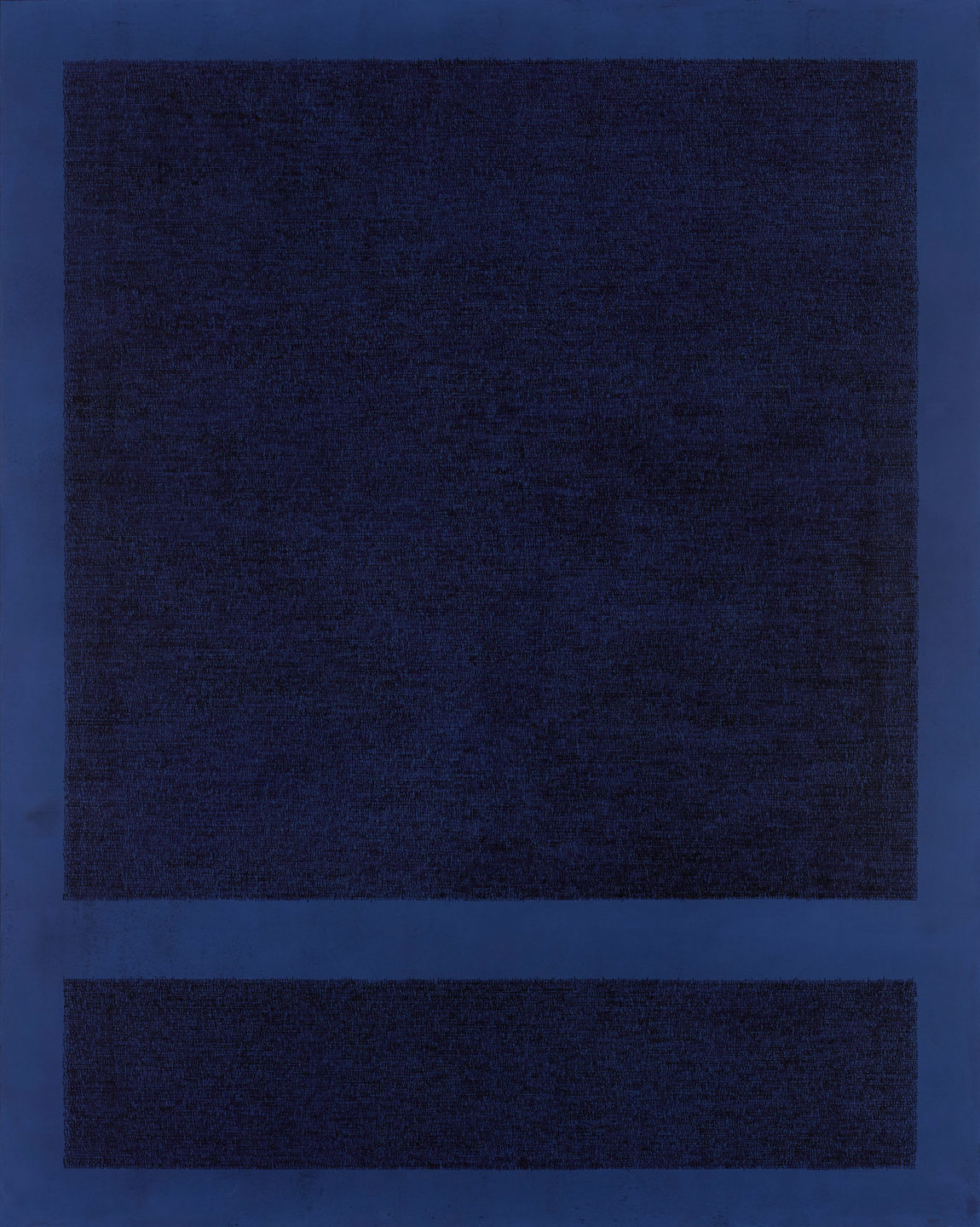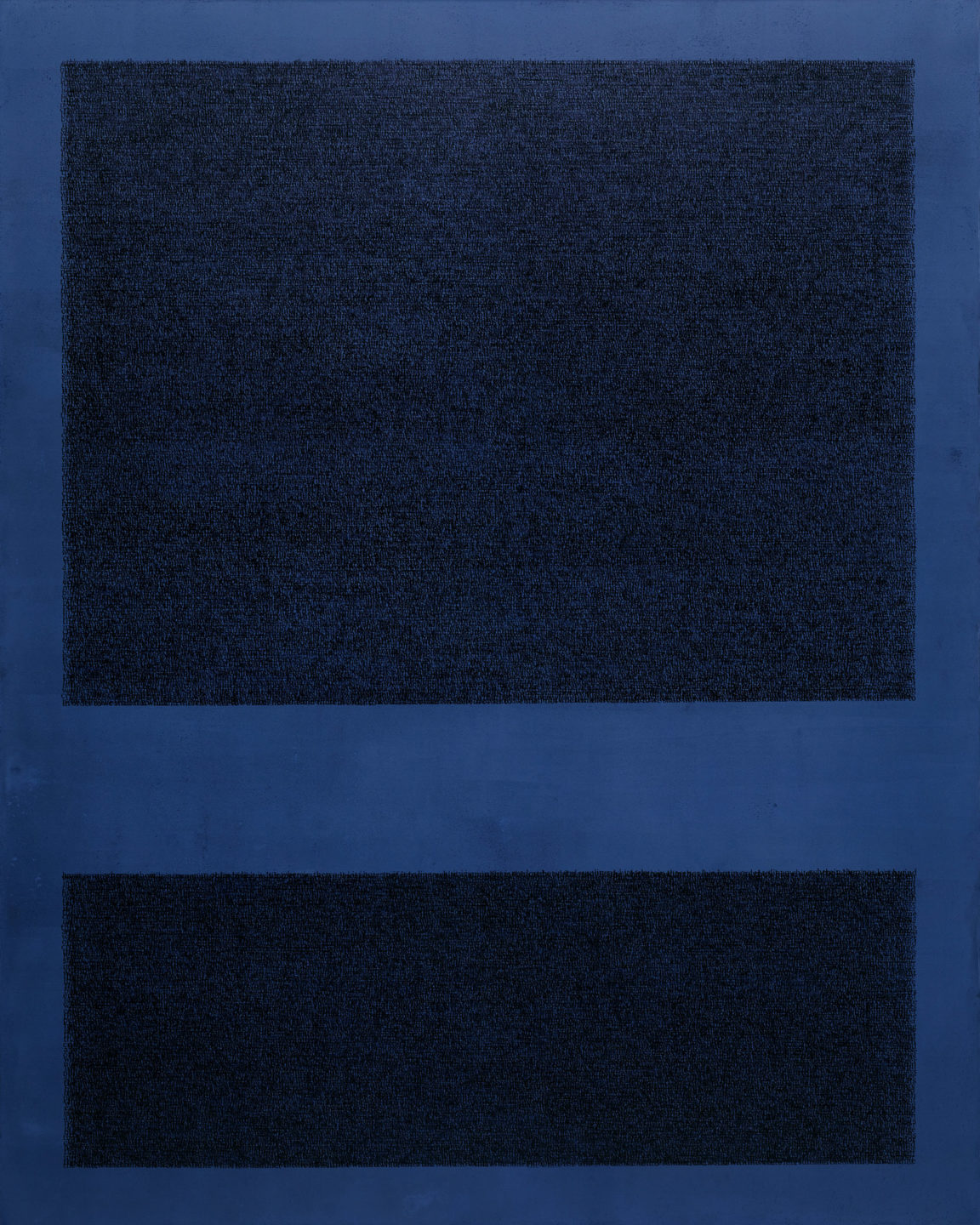Idris Khan: The Seasons Turn
13 April–15 May 2021
‘I’m inviting the viewer to fall into the words, colour and musical marks and bring their own thoughts and emotions to them.’ — Idris Khan
We are delighted to welcome visitors back with an exhibition of new works by Idris Khan.
Conceived of as two distinct installations, each a reflection on aspects of the past year, The Seasons Turn includes a suite of 28 watercolour and oil collaged works on paper that incorporate fragments of the score of Vivaldi’s The Four Seasons, and an environment of enveloping blue paintings whose rich bands of colour are layered with the artist’s thoughts, feelings and responses to the past twelve months.
Click here to book your timed reservation slot
The exhibition is also available to view virtually in our lower and upper galleries on Vortic, the leading virtual and augmented reality platform for the art world.
The Seasons Turn
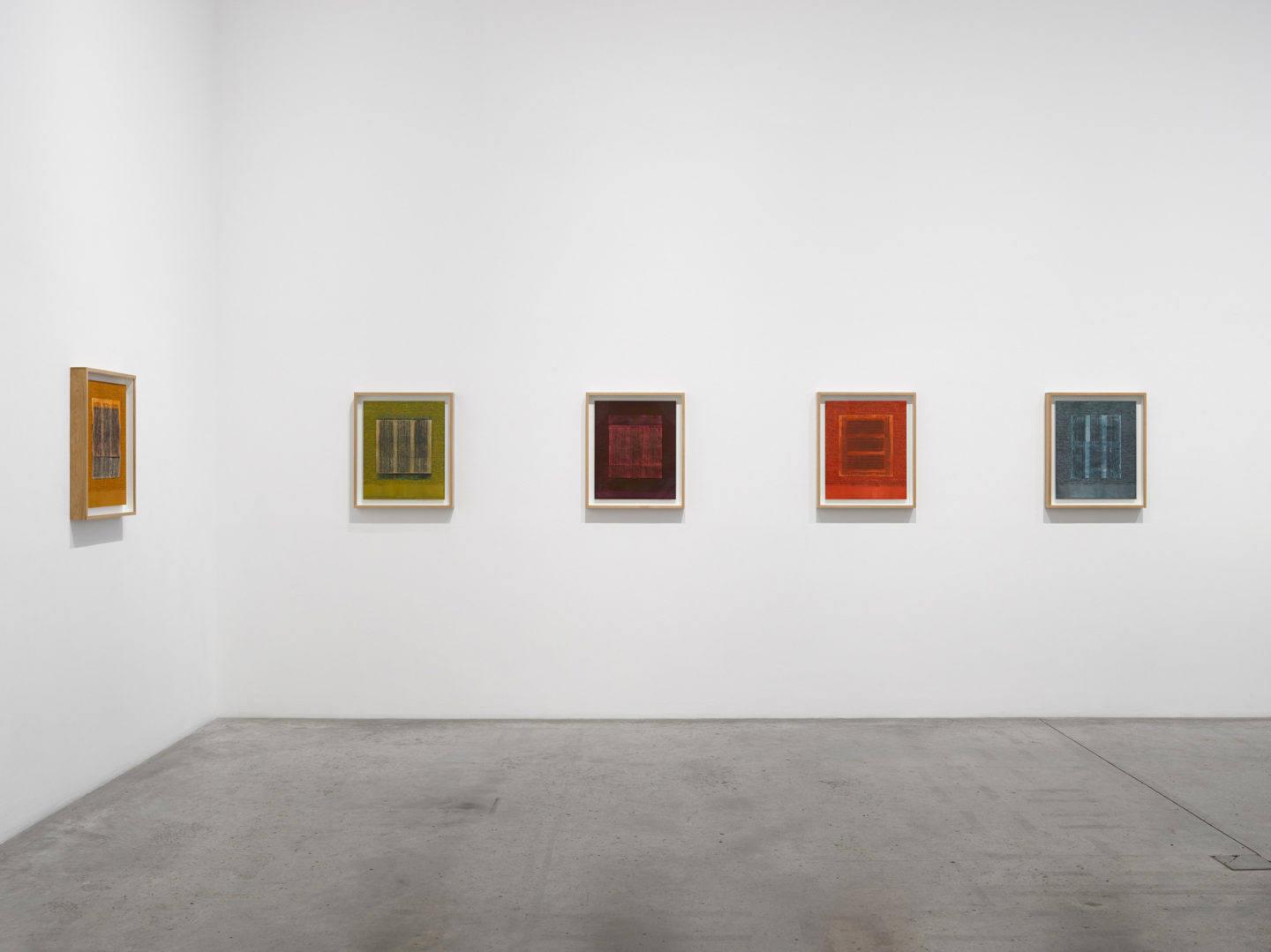
Watercolour and oil on aluminium with mounted paper bond and sheet music
28 panels, each:
55 x 45.5 cm
21 5/8 x 17 7/8 in
Idris Khan, The Seasons Turn, 2020–21
More info‘From blossom pinks, blues and yellows of spring, to the rich reds, greens and oranges of summer, the warm brown, burnt umber tones of autumn to the cold, black, dark greens of winter, I want the visitors in the gallery to walk around a year of the colours that were in my mind.’ — Idris Khan
Music in its written and played forms has long been a source of inspiration for Khan who, in two- and three-dimensional works and film, has reimagined the work of composers including Beethoven, Chopin, Schubert and Bach. In these new works Khan returns to Vivaldi’s baroque masterpiece The Four Seasons, using fragments of the violin concerti’s scores as a springboard for his own visual evocation of a calendar year.

Khan’s work has often alluded to the excessive proliferation of information in the technical age, whilst simultaneously advocating for a slower, more considered way of looking. Forced to slow down during this period of lockdown, in these works he reflects on his own increased awareness of the changing rhythms and colours of the natural world. As he says, ‘I’ve never lived in the country. I’ve always found myself living in cities or suburban towns and never really witnessed the vivid changes and colours of the seasons. I feel we’ve all had more time to reflect on these changes and be more aware of them, and thinking back now, being there I was almost turning my back to what was happening in the outside world and making mental notes of the colours I was seeing every day… From blossom pinks, blues and yellows of spring, to the rich reds, greens and oranges of summer, the warm brown, burnt umber tones of autumn to the cold, black, dark greens of winter, I want the visitors in the gallery to walk around a year of the colours that were in my mind, and when they look more intensely, to see that the marks and nuances on the surface express the tension and anxieties that depict the emotions and turbulence of the past year.’
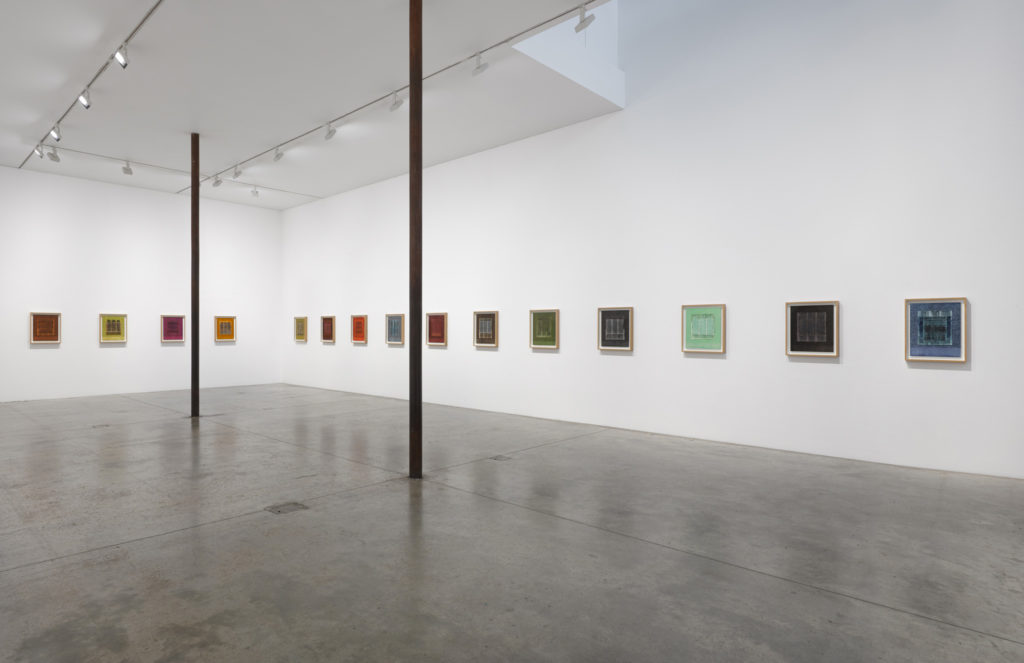
Seven works correspond with each of the seasons. Each individual work comprises a ground of watercolour in a selected hue on to which a smaller sheet, stamped with fragments of Vivaldi’s score in a contrasting or complementary colour, is affixed. Stamping further across the sheets in a free and improvisatory way, Khan arrives at combinations of colour and gesture that, referring to the natural world, also reflect his own emotions.
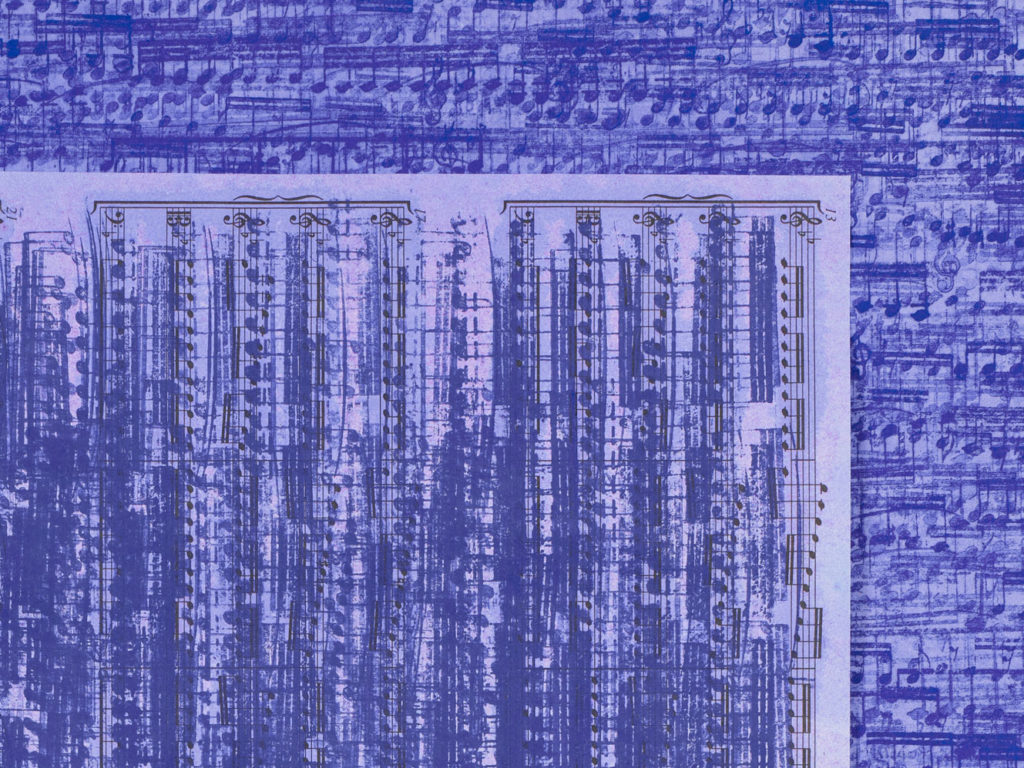
‘The paintings need to feel alive, to have movement and energy across the page.’ — Idris Khan
The effects are manifold. Just as Vivaldi’s work brims with allusions to nature, in Khan’s work colour – stepping forward here to become a major protagonist – changes with seasonal nuance. Yet, while the works line the gallery in chronological order – with a compositional linearity that might be considered akin to a line of music – individually and collectively they are subject to staccato change, each line of music a fragment of time that might be overlaid or repeated at any point in the year, irrespective of the music’s progression. For Khan, this manner of working is reflective of a year in which a sense of time’s passage and collapse has been unlike any other. It is one, as the artist says, ‘with uncertainty built into the process’. Yet, it is also one perfectly in tune with the ‘live’ quality of creating the work and the fortuitous emergence of unforeseen beauty.
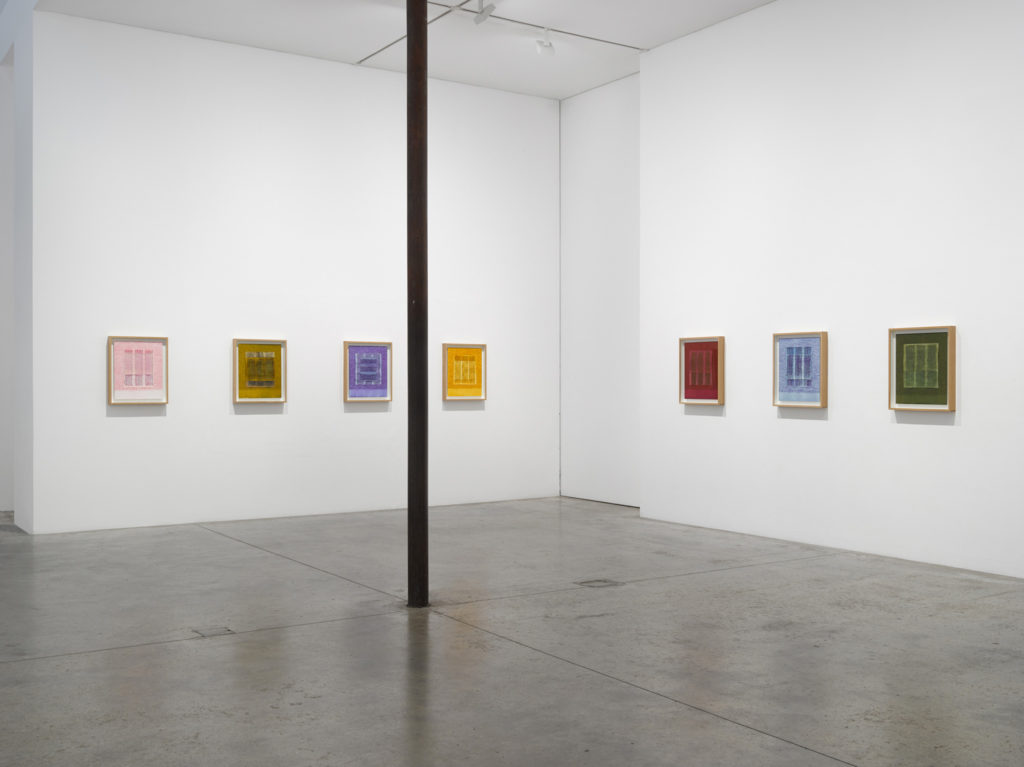
Blue paintings
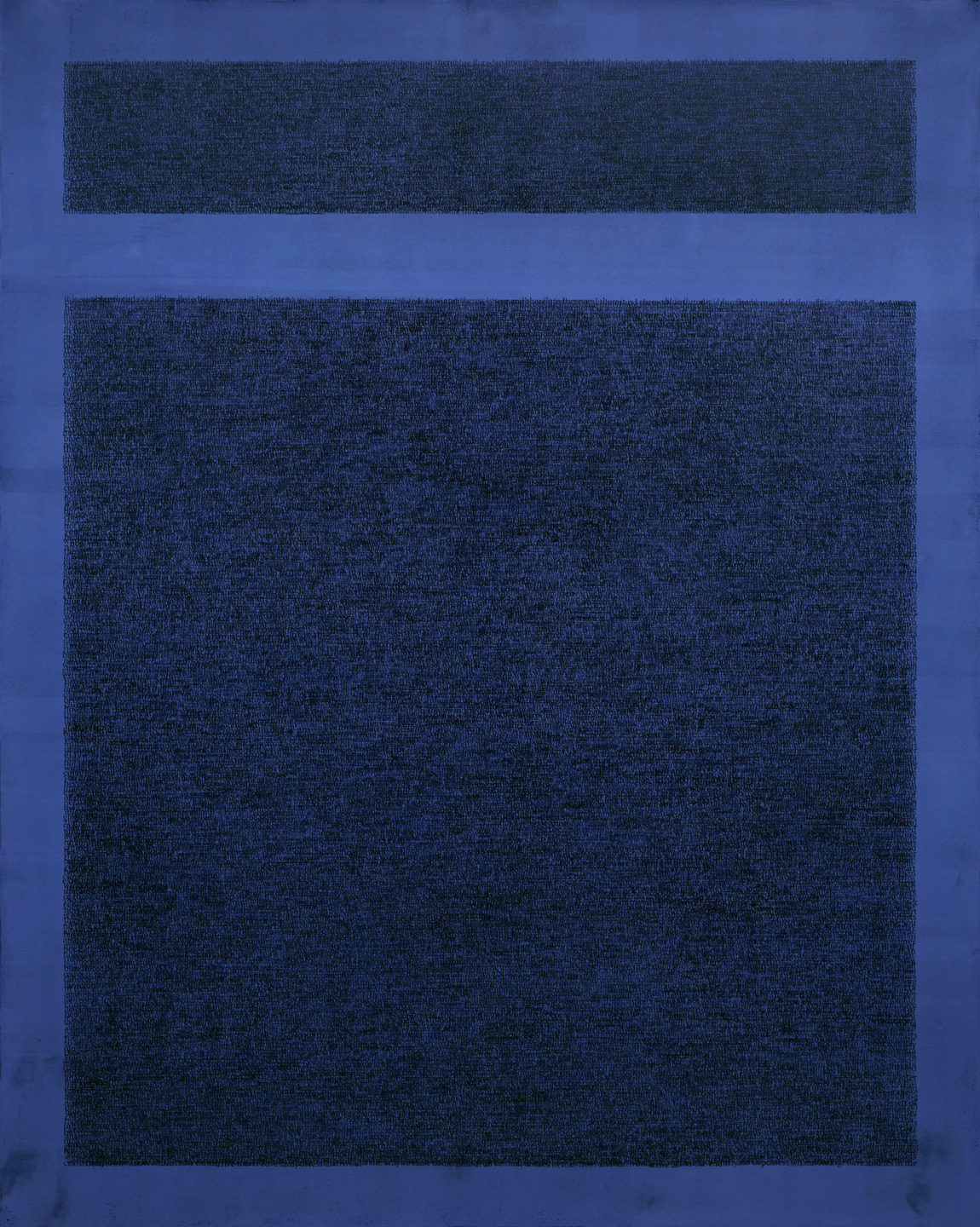
Oil based ink on gesso, on aluminium
250.5 x 200 cm
98 5/8 x 78 3/4 in
Idris Khan, Emotions Alter the World, 2020
More info‘The works are blue because I feel it has very spiritual and immediate effect on people’s emotions.’ — Idris Khan
On display in the upper gallery is an enveloping installation of large-scale blue paintings. Khan has often drawn inspiration from key philosophical and theological texts in his work, yet increasingly his own writings have become a conduit for investigating memory, creativity and the layering of experience. Unified by the use of the colour blue, using the artist’s own mix of gesso, rabbit skin glue, slate dust, marble dust and Prussian blue and Ultramarine blue pigments, the paintings on view feature passages of texts in which Khan expresses thoughts, feelings and responses to the past year.

Blue painting 2
‘I wanted a colour that you fell into, a colour that would envelop the soul.’ — Idris Khan
Diaristic in nature, these texts, once repeated and layered in sonorous blue oil, are distilled, a number of fragmentary experiences and disparate ideas becoming a single image. In this manner, while Khan ultimately eradicates the meaning of the original text, he constructs an abstract and universal language.
Blue painting 5
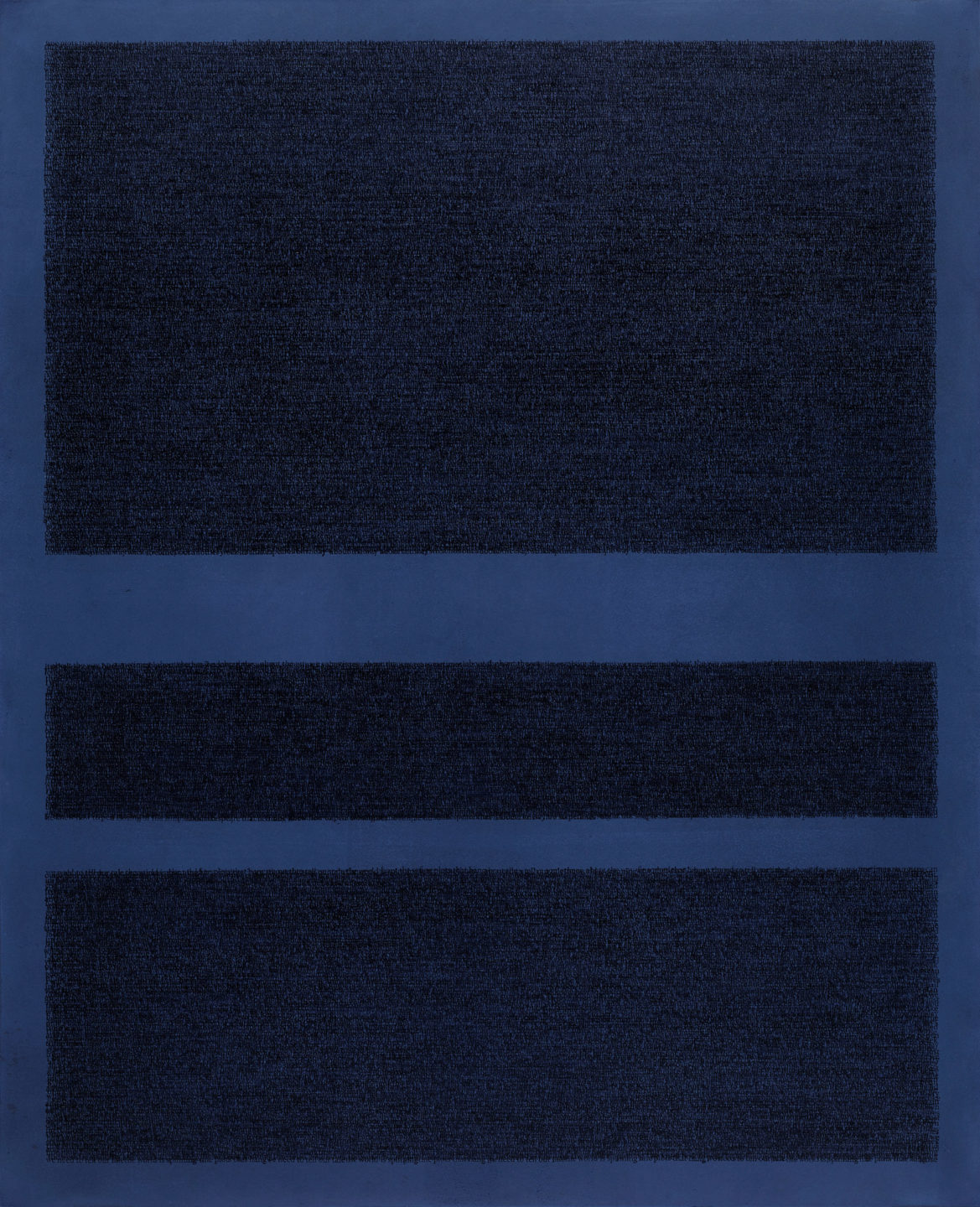
Oil based ink on gesso, on aluminium
160 x 130 cm
63 x 51 1/8 in
Idris Khan, Forest Paths, 2020
More info‘The horizontal bands move through each work around the room and appear to rise and fall almost like breathing, shifting in a rhythmical way.’ — Idris Khan
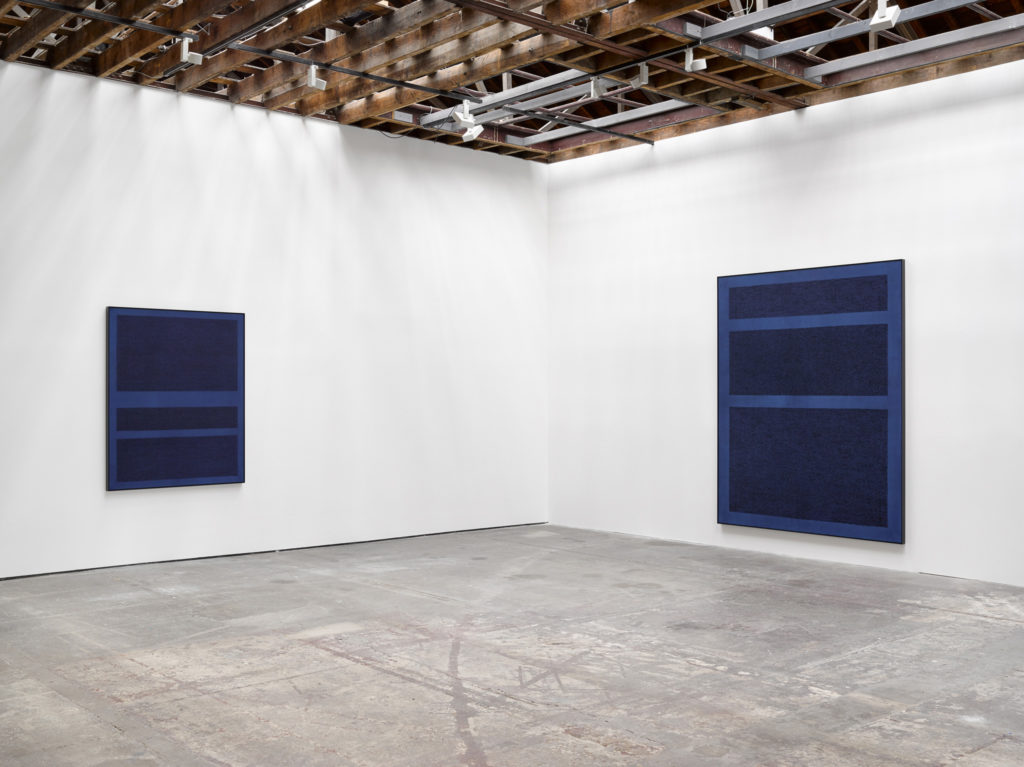
Blue painting 4
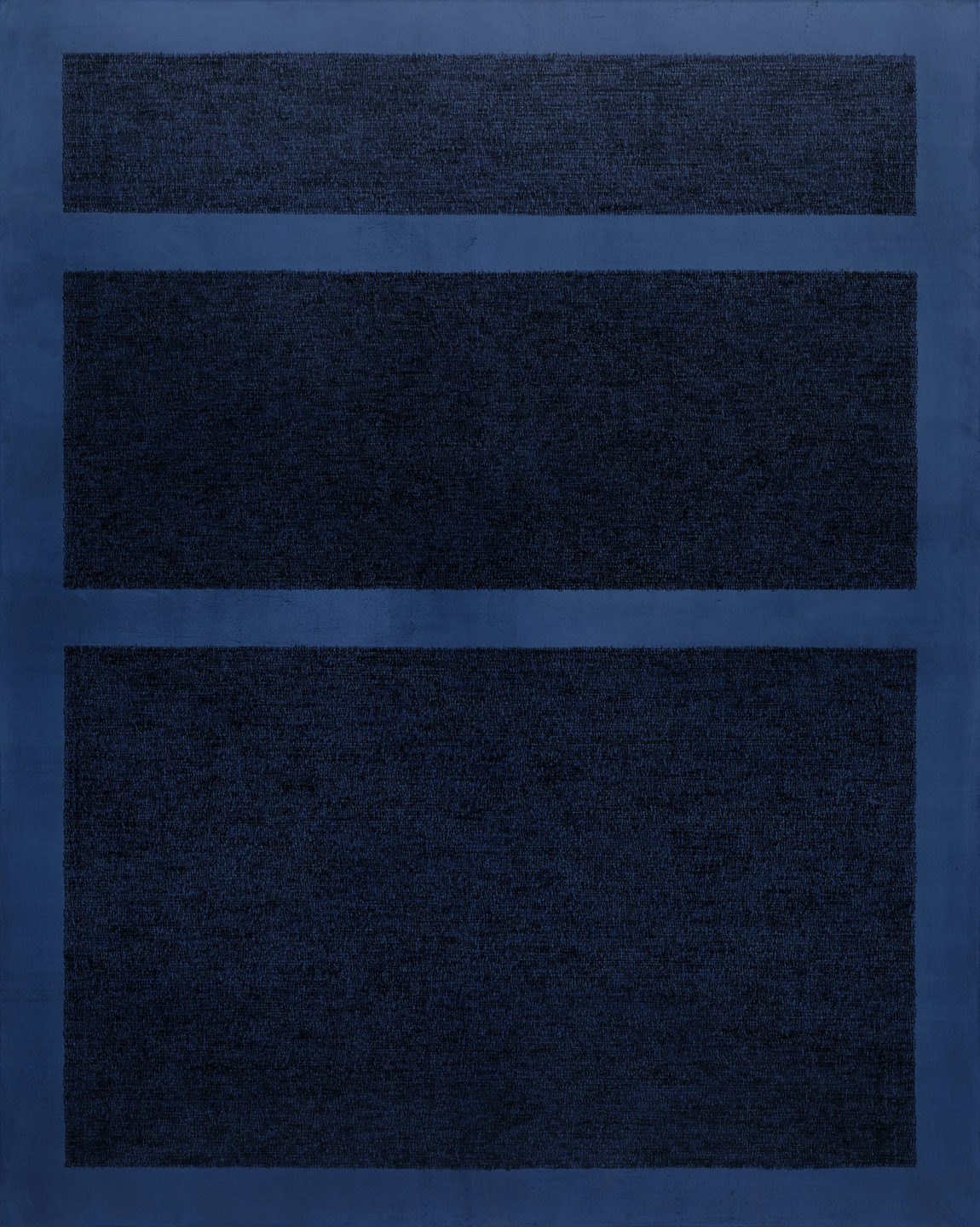
Oil based ink on gesso, on aluminium
250.5 x 200 cm
98 5/8 x 78 3/4 in
Idris Khan, Burnt Wood, 2020
More info‘The words are there at the start of the process, but as I make the paintings, the words lose their meaning, and what’s left is an abstract painting of internalised thoughts.’ — Idris Khan
Blue painting 3
Moving between the works in a specially conceived installation, the viewer becomes aware of the way in which each painting is subtly different. Khan explains, ‘I like the perception of seeing the paintings from a distance. They look like blocks of colour, and as you get closer you see the words being revealed. Gesso is a very absorbent surface, so the first layer sinks into it, almost freezing the words in time. And then as I layer, the language is eradicated. Often people ask me what’s written, but in the end it doesn’t matter. The words are there at the start of the process, but as I make the paintings, the words lose their meaning, and what’s left is an abstract painting of internalised thoughts. The horizontal bands move through each work around the room and appear to rise and fall almost like breathing, shifting in a rhythmical way that also relates to the musicality of the works in the Vivaldi series downstairs. I’m inviting the viewer to fall into the words, colour and musical marks and bring their own thoughts and emotions to them.’
It is in this contemplative space that both the processes of Minimalist art and allusions to the role of repetition in the world’s major religions are brought into focus – as a vehicle for transcendence and a conduit of the sublime.
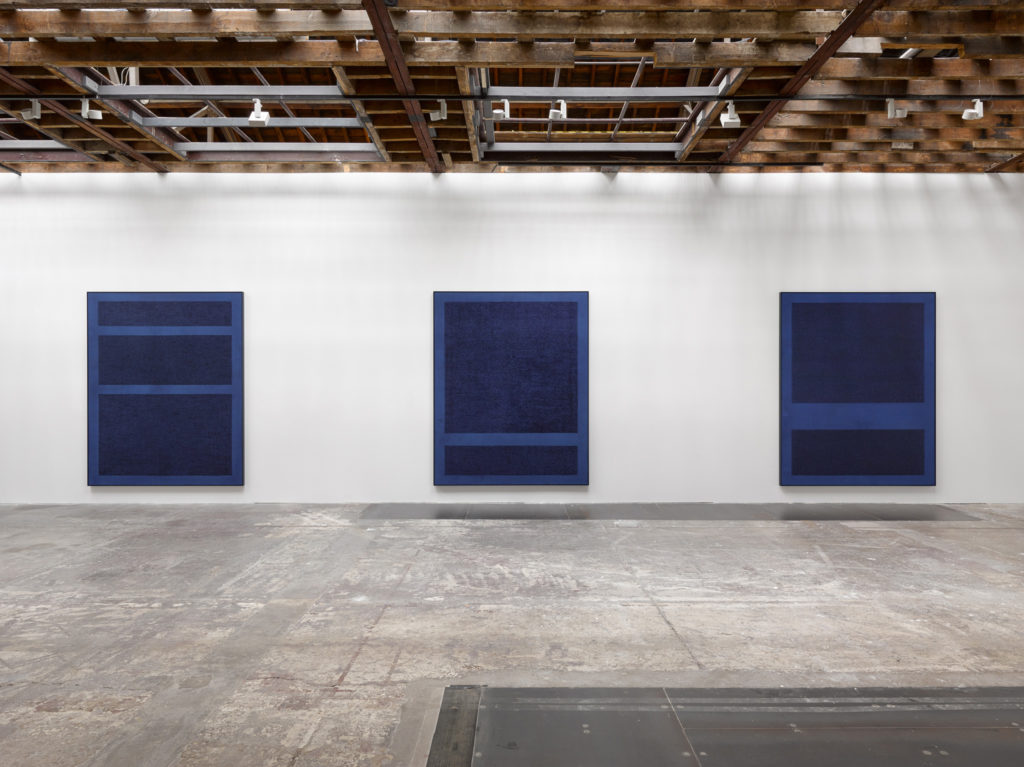
Blue painting 5a
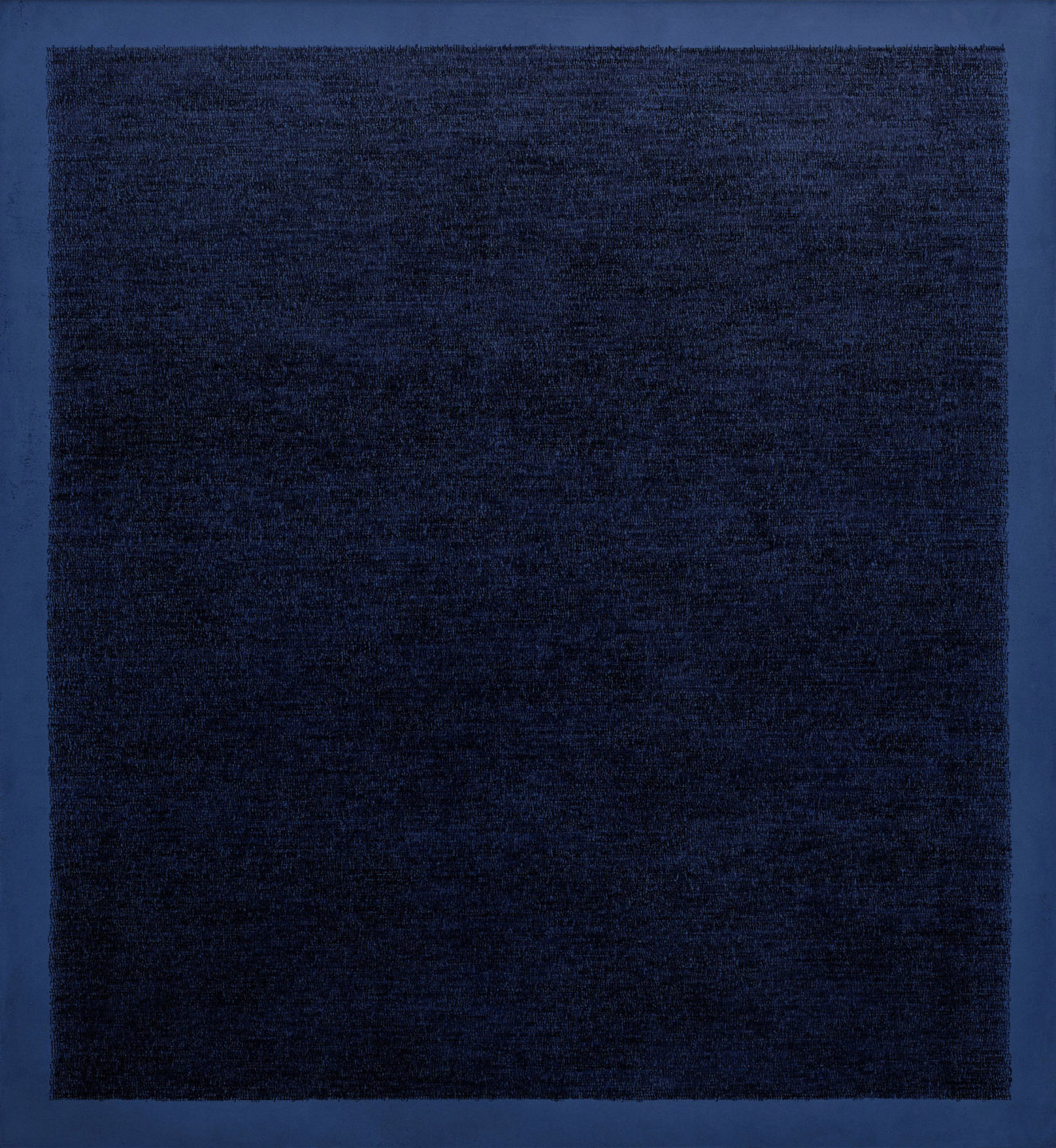
Oil based ink on gesso, on aluminium
141 x 130 cm
55 1/2 x 51 1/8 in
Idris Khan, There are no eyes here, 2020
More info‘I love the light in this gallery, constantly shifting across the paintings.’ — Idris Khan
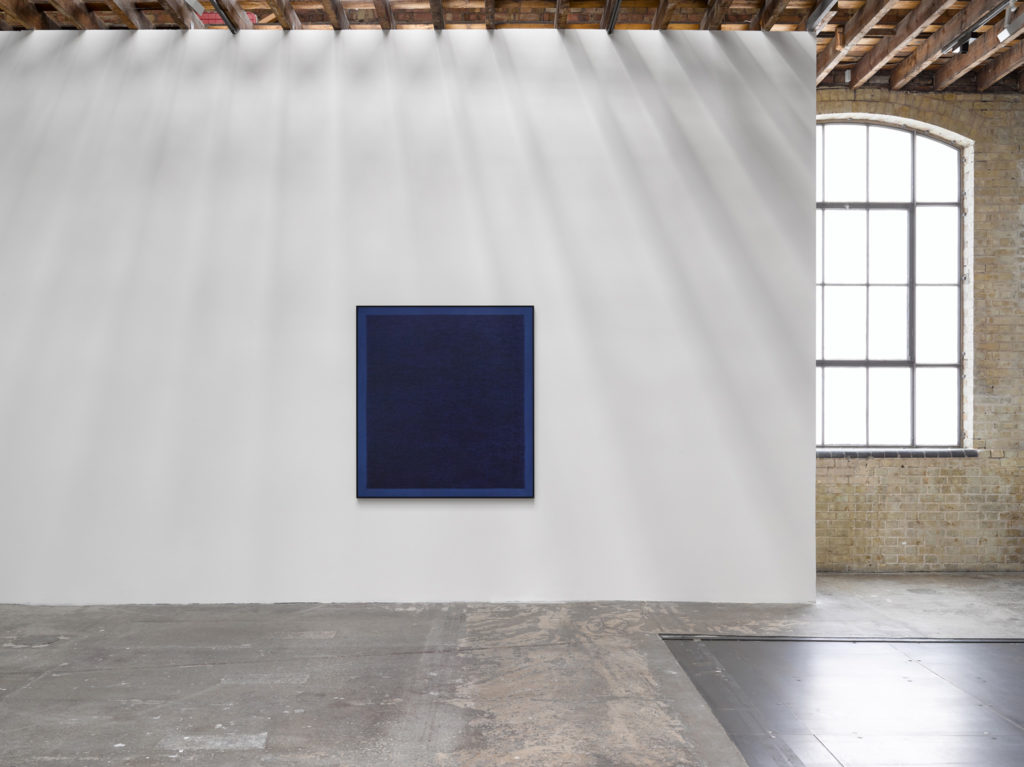
About the artist
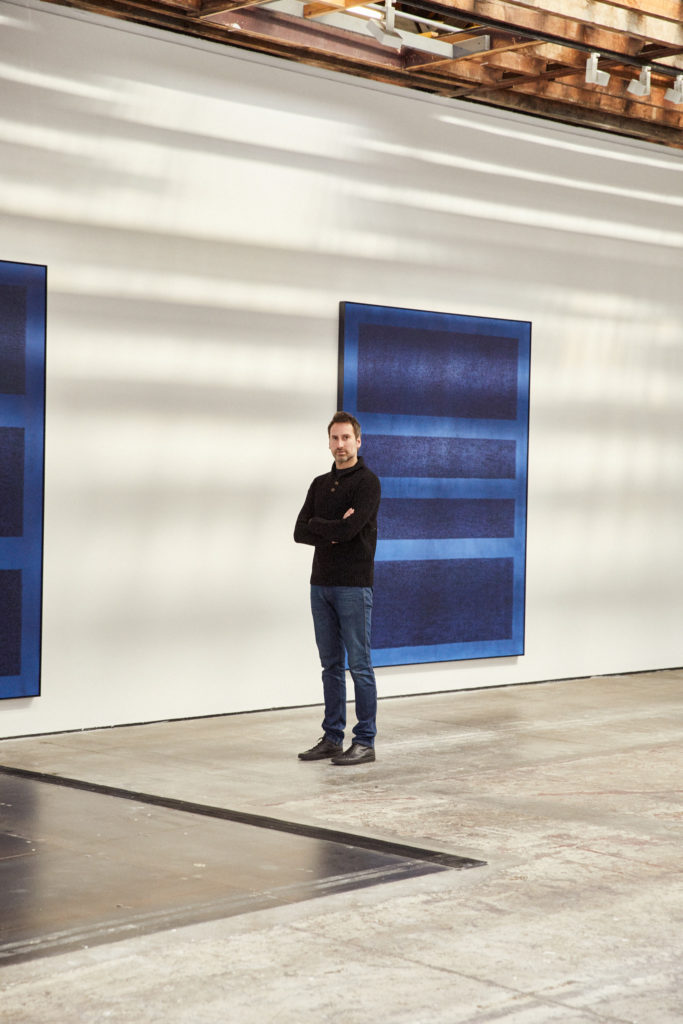
Born in Birmingham in 1978, Idris Khan completed his Master’s Degree at the Royal College of Art and lives and works in London. He was appointed OBE for services to Art in the Queen’s Birthday 2017 Honours List. In 2023, Milwaukee Art Museum, Milwaukee, Wisconsin, USA will present the first career survey exhibition by the artist in the United States.
A major survey exhibition Idris Khan: A World Within was held at The New Art Gallery Walsall in February 2017, with solo presentations of the artist’s work previously staged at national and international institutional venues including the Whitworth Gallery, University of Manchester (2016-2017 and 2012); Sadler’s Wells, London (2011); Gothenburg Konsthall, Sweden (2011); Museum of Contemporary Canadian Art, Toronto (2010); Kunsthaus Murz, Mürzzuschlag, Austria (2010) and K20, Düsseldorf (2008). His work has also been included in group shows at the National Gallery of Art, Washington (2015); Bass Museum of Art, Miami (2014–2015); Tel Aviv Museum of Art (2014); Jeu de Paume, Paris (2013); Museum of Contemporary Art, Jacksonville, Florida (2013); The British Museum, London (2012); National Museum of Contemporary Art, Oslo (2012); Fundament Foundation, Tilburg (2011); Solomon R Guggenheim Museum, New York (2010); and Martin-Gropius Bau, Berlin (2009).
A major public sculpture for London by Khan, commissioned by St George’s Plc with London Borough of Southwark as part of the development of One Blackfriars, was unveiled in autumn 2019. Khan’s 21 Stones is currently displayed in The Albukhary Foundation Islamic Gallery, which recently opened at the British Museum, London. 21 Stones is the British Museum’s first site-specific artwork. In 2016, Khan was commissioned to make a permanent public monument, forming the centrepiece of the new Memorial Park in Abu Dhabi, which was unveiled on the UAE Commemoration Day. In 2017, it received an American Architecture Prize, a World Architecture News Award and a German Design Award. Further commissions include a wall drawing commissioned by the British Museum in 2012 for its exhibition Hajj: Journey to the Heart of Islam. In addition, for the duration of the exhibition, Khan’s monumental floor installation, Seven Times, was installed in the museum’s Great Court.

